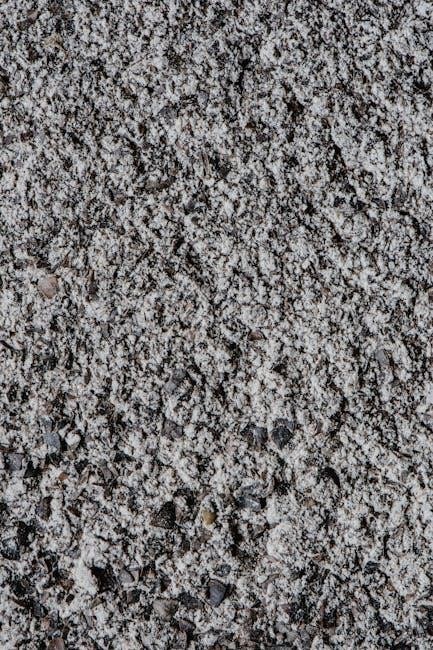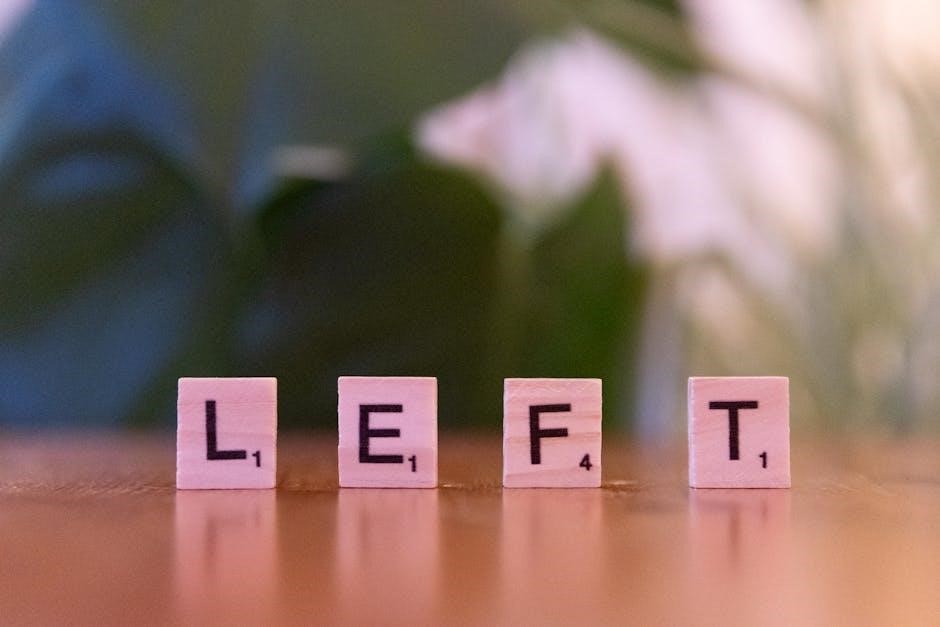Surface Finish: An Overview
Surface finish refers to the characteristics of a surface‚ including roughness and texture. It plays a crucial role in the performance and appearance of manufactured parts. A proper surface finish can enhance functionality and aesthetics.
Definition and Importance of Surface Finish
Surface finish is defined as the geometric irregularities present on a solid material’s surface‚ impacting its tactile and visual qualities. These irregularities‚ often resulting from manufacturing processes‚ are critical to a component’s performance. A suitable surface finish can minimize friction‚ prevent wear‚ and improve fatigue resistance. Surface finish impacts the ability of the surface to reflect light and give the surface a visual aspect. Moreover‚ a precisely controlled surface finish is vital for achieving optimal sealing. Therefore‚ careful consideration of surface finish is essential in engineering design and manufacturing.
Surface Roughness Parameters
Surface roughness parameters quantify the texture of a surface. These parameters‚ including Ra‚ Rz‚ and Ry‚ provide numerical values representing surface deviations. These parameters are essential for quality control.
Arithmetic Mean Roughness (Ra)
Arithmetic Mean Roughness (Ra) is a widely used parameter in surface finish measurement. It represents the average absolute deviation of the surface profile from the mean line. Ra is calculated by summing the absolute values of the vertical distances from the mean line and dividing by the evaluation length. Ra provides a general indication of surface roughness.
A lower Ra value indicates a smoother surface‚ while a higher Ra value indicates a rougher surface. Ra is expressed in micrometers (µm) or microinches. It’s a versatile parameter for various applications.
Ten-Point Mean Roughness (Rz)
Ten-Point Mean Roughness (Rz) is another parameter used to define surface texture. It is calculated by measuring the average height between the five highest peaks and the five lowest valleys within the evaluation length. Rz is more sensitive to extreme peaks and valleys than Ra. This makes it useful for detecting flaws.
Rz provides a more comprehensive assessment of surface irregularities. Rz is expressed in micrometers (µm) or microinches. It is particularly relevant where surface peaks and valleys significantly impact performance or functionality. Rz is commonly used in European standards.
Maximum Peak (Ry)
Maximum Peak (Ry)‚ also known as maximum height‚ describes the largest peak-to-valley height on a surface within a defined evaluation length. Unlike Ra and Rz‚ Ry focuses solely on the single largest deviation from the mean line‚ emphasizing extreme surface features;
Ry is highly sensitive to scratches or defects. It provides a quick indication of the severity of surface imperfections. Ry is measured in micrometers (µm) or microinches. It is useful for assessing surfaces where even a single large peak could cause issues. Ry helps ensure quality.

Surface Finish Measurement Techniques
Surface finish measurement techniques are used to quantify the texture of a surface. These techniques include contact methods like profile-meters and non-contact methods utilizing optical principles. They provide data for analysis and comparison.
Profile-Meter Measurement
Profile-meter measurement is a contact method for assessing surface finish‚ employing a stylus that traverses the surface. As the stylus moves‚ its vertical displacement is recorded‚ generating a profile of the surface texture. This profile reveals peaks and valleys‚ enabling the calculation of various roughness parameters.
Profile-meters are widely used due to their accuracy and versatility in measuring diverse surface types. The data obtained from profile-meter measurements are essential for quality control‚ ensuring surface finish meets specified requirements. These measurements help optimize manufacturing processes and predict product performance.
Calibration is often performed using standards traceable to national metrology institutes.

Surface Finish Standards
Surface finish standards‚ like ISO 25178-603:2013 and ASTM F1048‚ provide standardized methods for measuring and specifying surface texture. These ensure consistency and comparability in manufacturing and quality control processes.
ISO 25178-603:2013
ISO 25178-603:2013‚ part of Geometrical Product Specifications (GPS)‚ focuses on surface texture using areal methods. It provides nominal characteristics for non-contact‚ phase-shifting instruments. This standard ensures accurate measurement of surface topography. It defines parameters and procedures. It is used for characterizing surface features. ISO 25178-603 promotes consistency in surface finish assessment. It’s applicable in various industries for quality control. It aids in evaluating surface functionality. The standard helps maintain uniformity across manufacturing processes. It contributes to enhanced product performance; This ensures reliable surface texture analysis. Compliance with ISO standards is crucial for precision. It facilitates international trade and collaboration; The standard advances surface metrology practices and applications. It is very important!
ASTM Standard F1048
ASTM Standard F1048 outlines a test method for assessing the effective surface roughness of optical components. It employs total integrated scattering measurements. This standard provides a quantitative measure of surface quality. It ensures consistency in optical performance. The method is applicable to various optical materials. It helps in evaluating the impact of surface imperfections. The standard is essential for quality control in optics. It assists in optimizing manufacturing processes. ASTM F1048 is critical for applications requiring precise optics. It helps minimize light scattering effects. It ensures optimal image quality and resolution. The standard supports the development of high-performance optical systems. Compliance with ASTM standards ensures reliability. It promotes uniformity in optical component assessment. It facilitates collaboration in the optics industry. It advances surface metrology for optical applications. This ensures the best results!

Surface Texture Symbols on Technical Drawings
Technical drawings use standardized symbols to specify surface texture requirements. These symbols convey crucial information about the desired surface finish. International standards like ISO define these symbols. They ensure clear communication between designers and manufacturers. The symbols indicate parameters like roughness and lay direction. They might also specify manufacturing processes affecting surface texture. Understanding these symbols is vital for interpreting technical drawings. It ensures accurate production of parts with the specified surface finish. Proper application of these symbols minimizes ambiguity. It prevents costly errors in manufacturing. Surface texture symbols are essential for quality control. They provide a reference for verifying the final surface finish. They contribute to the overall functionality and performance. Effective use of symbols enhances communication and precision. It promotes efficient manufacturing processes. This improves the product’s overall quality.
Surface Finish and Material
Surface finish varies significantly depending on the material used. Aluminium composites‚ for instance‚ exhibit specific roughness characteristics. These characteristics are influenced by drilling and other manufacturing processes. The surface treatment impacts the final roughness.
Aluminium Composite Surface Roughness
The surface roughness of aluminum composites is a critical factor in various applications. Studies‚ like those examining Al7075‚ explore how drilling impacts surface finish. Achieving superior surface finish is often prioritized‚ especially with edge treatments designed to enhance quality. Economical inserts can contribute to achieving desired surface finishes on aluminum composite materials. Proper measurement and control of surface roughness are essential for optimizing the performance and longevity of components made from these materials. Understanding the relationship between manufacturing processes and surface finish is crucial for engineers working with aluminum composites.

Applications of Different Surface Finishes
Surface finishes dictate the suitability of materials in various applications. Matte finishes offer a practical aesthetic‚ while polished finishes provide enhanced reflectivity. Textured patterns can improve grip or visual appeal‚ extending their applicability. Mirror finishes are often utilized where high reflectivity is needed. Electropolishing is used where smoothness and corrosion resistance are critical. Specific surface finish requirements vary‚ influencing the choice for functionality. Each finish offers a blend of aesthetic and functional properties‚ dictating optimal use. Choosing the right surface finish ensures performance‚ longevity‚ and desired appearance of any product.
Surface Finish Cross Reference Chart
A surface finish cross-reference chart is a valuable tool that correlates different surface roughness measurement scales and standards. It bridges the gap between grit numbers‚ common names‚ and Ra values‚ providing a comparative reference. Such charts enable engineers and manufacturers to easily convert between different measurement systems‚ ensuring consistent surface quality. The chart typically includes Ra in microinches and micrometers‚ along with equivalent grit numbers and standard designations. This reference helps in selecting appropriate finishing techniques. This facilitates clear communication and accurate specification of surface finish requirements across various industries and international standards‚ thus streamlining manufacturing processes.

